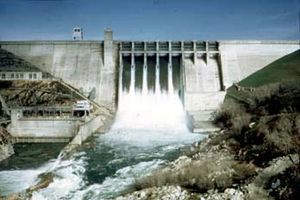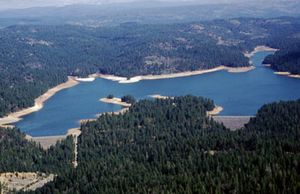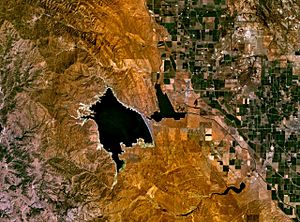Central Valley Project facts for kids

Map showing CVP facilities in the state of California.
|
|

Map of CVP canal system in the San Joaquin Valley. CVP aqueducts are in blue while SWP aqueducts are in red.
|
|
| General statistics | |
|---|---|
| Begun | 1933 |
| Storage dams | Auburn (canceled) Contra Loma Folsom Friant Funks New Melones San Justo San Luis Shasta Sly Park Trinity Whiskeytown |
| Additional dams | Camp Creek Diversion County Line (unbuilt) Keswick Lewiston Little Panoche Los Baños Nimbus Red Bluff O'Neill Spring Creek Sugar Pine |
| Power plants | Friant (25 MW) Folsom minha (199 MW) Judge Francis Carr (154 MW) Keswick (117 MW) New Melones (300 MW) Nimbus (7.7 MW) Shasta (676 MW) Spring Creek (180 MW) Trinity (140 MW) William R. Gianelli (424 MW) |
| Canals | 643.6 mi (1,035.8 km) |
| Operations | |
| Storage capacity | 13,410,683 acre-feet (16,541,834 dam3) |
| Annual water yield | 7,000,000 acre-feet (8,600,000 dam3) |
| Land irrigated | 3,000,000 acres (1,200,000 ha) |
| Total generation capacity | 2,254 MW |
| Total annual generation | 5.18 TWh (2004) |
The Central Valley Project (CVP) is a huge system of dams, canals, and power plants in California. It was started in 1933 by the U.S. government. Its main goal is to move water from the wetter northern part of California to the drier southern part. This water is used for farming and for cities.
The CVP also creates electricity from water power, helps control floods, and offers places for fun activities. It has helped cities grow and turned dry areas into rich farmland. The project also helps keep salt water from flowing into the Sacramento-San Joaquin Delta during dry times.
However, the CVP has also caused some environmental problems. It has affected fish like salmon and changed natural areas. Some Native American lands were flooded when reservoirs were built. Also, water from farms has sometimes polluted rivers. In 1992, a law called the Central Valley Project Improvement Act was passed. It aims to fix some of these problems.
In recent years, California has faced droughts. Rules to protect endangered fish have also limited how much water the CVP can deliver. This has caused problems for farmers. For example, in 2017, salmon populations were very low, leading to fishing bans.
Contents
What is the Central Valley Project?
How the CVP Works
The CVP stores about 13 million acre-feet of water in 20 reservoirs. These reservoirs are in different mountain ranges across California. Each year, the CVP moves about 7.4 million acre-feet of water through its canals. About 5 million acre-feet go to water 3 million acres of farmland. Another 600,000 acre-feet supply cities. About 800,000 acre-feet are released into rivers and wetlands to help nature.
Two large lakes, Shasta Lake and Trinity Lake, are key parts of the system. Shasta Lake feeds the Sacramento River, which flows to the Delta. Trinity Lake feeds the Trinity River, which goes to the Pacific Ocean. Water from these lakes is released carefully. Some water from the Delta is sent south through the Delta-Mendota Canal. This canal brings water to the San Luis Reservoir and the San Joaquin River.
Further south, Friant Dam on the San Joaquin River sends water into canals. These canals reach the Tulare Lake area and even the Kern River. Another important part is New Melones Lake, which stores water from a San Joaquin River branch. Other smaller projects also help local farms get water.
Why Was the CVP Built?
The Central Valley Project was one of the biggest water and power projects in the world. It was built during the New Deal in the 1930s. For 80 years before that, people in California argued about water. The Central Valley has dry summers and wet winters, with droughts happening often.
When the project was built, there was a big debate about how California's land should be used. This included arguments over water rights, how it would affect Native American communities, and who should control power. The people who supported the project often didn't think much about its environmental effects.
Before Europeans arrived, Native American tribes lived in the Central Valley for thousands of years. They were hunter-gatherers. Later, Spanish missions and ranches used the land, often with forced labor. After California became part of the U.S., farming grew. The Central Valley became a major food-producing area.
Early farmers tried to grow crops with just rain. But the Sacramento Valley in the north often flooded, and the San Joaquin Valley in the south didn't have enough water. The Sacramento River gets most of the rain, even though the San Joaquin Valley is much larger. Cities also struggled to get water in dry months. So, a system was needed to control river flows and share water.
How the CVP Developed Over Time
The idea for the CVP started in 1873 with a report by the U.S. Army Corps of Engineers. The Bureau of Reclamation became interested in the early 1900s. California passed its own CVP Act in 1933. But because of the Great Depression, the state needed money from the national government.
The first dams and canals began to be built in the late 1930s. Most of the project was finished by the early 1970s. Some parts were never built, or are still waiting to be completed.
Key Moments in CVP History
- 1873: First idea for a Central Valley Project.
- 1902: The National Reclamation Act creates the United States Bureau of Reclamation (USBR).
- 1920s: A series of droughts makes the need for a water project clear.
- 1933: California passes the Central Valley Project Act. The state then asks the federal government for help.
- 1935: The USBR takes over the CVP. Rules are set that water should go to smaller farms (160 acres or less).
- 1938: Construction begins on Shasta Dam, a major part of the CVP.
- 1940: The Contra Costa Canal delivers its first water.
- 1942: Friant Dam is completed.
- 1944: Shasta Dam starts producing electricity.
- 1949: Water from Friant Dam is released into the San Joaquin Valley. The Friant-Kern Canal opens.
- 1951: Shasta Dam starts sending water into CVP canals.
- 1958: The U.S. Supreme Court supports the 160-acre limit for water users.
- 1965: Construction begins on the San Luis Reservoir, a shared project.
- 1970s: Environmental groups start to raise concerns about the CVP.
- 1978: The U.S. Supreme Court rules that California can enforce environmental rules on federal water projects.
- 1982: Voters in California reject the Peripheral Canal plan.
- 1992: The Central Valley Project Improvement Act (CVPIA) is passed. It aims to balance water use with environmental protection.
- 2000: Westlands Water District wins a lawsuit against the USBR over drainage issues.
- 2009: The Delta smelt, a small fish, is listed as endangered. This leads to more water limits.
- 2017: The Oroville Dam spillway has problems, causing many people to evacuate.
CVP Facilities in Northern California
Sacramento River Facilities
The Shasta Division is home to Shasta Dam, which is the main water storage and power plant for the CVP. It creates Shasta Lake, which holds over 4.5 million acre-feet of water. The dam can also make 680 megawatts of power. Shasta Dam helps control the Sacramento River's flow. This makes it easier for other dams and canals to take water. It also helps prevent floods in the Delta. Downstream, Keswick Dam helps regulate water from Shasta Dam and also makes power.
Further down the Sacramento River, the Sacramento Canals Division takes water. Dams and pumps send water to cities and irrigate about 100,000 acres of farmland. The Red Bluff Diversion Dam used to send river water into canals. It has since been replaced with a pumping plant to help fish.
Trinity River Facilities
The Trinity River Division moves water from the Trinity River into the Sacramento River system. This adds more water to the Sacramento River and creates electricity. Trinity Dam forms Trinity Lake, the second largest CVP reservoir. It holds over half the water of Shasta Lake and can make 140 megawatts of power.
Downstream, Lewiston Dam sends water through a tunnel to Whiskeytown Lake. This process creates 154 megawatts of power. Whiskeytown Lake then sends water through another tunnel to Keswick Reservoir, making another 180 megawatts. This water eventually joins the Sacramento River. The Spring Creek Debris Dam was built to stop pollution from an old mine.
American River Facilities
The American River Division is in north-central California. It uses water from the American River, which flows from the Sierra Nevada. This division stores water for local communities and the rest of the CVP. It also helps control floods. Power is made at Folsom Dam and Nimbus Dam.
The Folsom Unit includes Folsom Dam, which creates Folsom Lake. This lake holds over 1 million acre-feet of water and covers 11,550 acres. The dam also makes 200 megawatts of power. About 7 miles downstream is Nimbus Dam, which forms Lake Natoma. Nimbus Dam makes 7.7 megawatts of power. The Nimbus Fish Hatchery helps replace fish spawning grounds lost because of the dams.
The Sly Park Unit has Sly Park Dam and Jenkinson Lake. Jenkinson Lake feeds the Camino Conduit, a 5-mile aqueduct. The Camp Creek Diversion Dam also sends water into Jenkinson Lake.
The Auburn-Folsom South Unit includes dams on American River branches. These include Sugar Pine Dam. The main part, Auburn Dam, was planned but never built. This was due to earthquake risks and public opposition.
CVP Facilities in Southern California
Delta and Canal System
A very important part of the CVP in the San Joaquin Valley is the system of aqueducts and pumps. These take water from the Sacramento-San Joaquin Delta and send it south. The Delta Cross Channel helps direct Sacramento River water south through natural and man-made channels.
From there, the C.W. Bill Jones Pumping Plant lifts water into the Delta-Mendota Canal. This canal travels 117 miles south to the San Joaquin River. It provides water to farms and cities. A special facility at the pump plant helps catch fish. Another canal, the Contra Costa Canal, takes water from the Delta and sends it 48 miles south.
San Joaquin River Facilities
The CVP also has dams on the San Joaquin River, which has less water than the Sacramento River. These dams send water to southern Central Valley aqueducts. Friant Dam, finished in 1942, is the largest part of the Friant Division. It creates Millerton Lake, which stores water for farms. It also sends water into two canals: the Friant-Kern Canal and the Madera Canal.
The Friant-Kern Canal sends water south through the Tulare Lake area all the way to Bakersfield. It provides water for farms in Tulare, Fresno, and Kern counties. The Madera Canal sends water north to Madera County. The CVP also has 500 miles of canals. Selling power from electricity generation helps pay for the project.
Stanislaus River Facilities
On the Stanislaus River, a major branch of the San Joaquin, is the New Melones Dam. This dam forms New Melones Lake, which can hold almost 2.4 million acre-feet of water. This is about the same as Trinity Lake. The dam stores water during dry times and releases it when needed. It also makes 279 megawatts of power.
Offstream Storage and Aqueducts
The CVP has many facilities on the west side of the San Joaquin Valley. These store and move water. The West San Joaquin Division and San Luis Unit share facilities with the California State Water Project (SWP). San Luis Dam is the largest storage facility, holding 2 million acre-feet of water.
Water is pumped from the Delta-Mendota Canal into O'Neill Forebay and then uphill into San Luis Reservoir. This reservoir provides extra water during dry periods. Water from San Luis and O'Neill reservoirs flows into the San Luis Canal. This canal carries both CVP and SWP water. It is one of the largest irrigation canals in the U.S. The Coalinga or Pleasant Valley Canal branches off the San Luis Canal.
Two other dams, Los Baños Detention Dam and Little Panoche Detention Dam, help control floods. The San Luis Drain was a project to keep polluted farm water out of the San Joaquin River. It was never finished due to environmental concerns.
The CVP also has a San Felipe Division. It supplies water to 63,500 acres in the Santa Clara Valley. San Justo Dam stores water from San Luis Reservoir.
How the CVP Affects Nature
Before the CVP, many fish like salmon and steelhead swam up the Sacramento and San Joaquin Rivers to lay their eggs. Building CVP dams, especially Friant Dam and Shasta Dam, greatly reduced these fish runs. Fish can no longer reach many parts of these rivers. In some places, the dams are too high for fish to get around them.
On the San Joaquin River, about 60 miles of the river are often dry because of water taken by Friant Dam. Even where water is added back, it can be polluted by farm runoff. Efforts to move salmon to other rivers, like the Merced River, did not work because the salmon didn't recognize them as their home.
The Red Bluff Diversion Dam on the Sacramento River also caused problems for migrating fish. Its fish passages didn't work well, and predators gathered there. This dam has now been replaced with a fish screen and pumping plant to help fish pass safely. Further upstream, Keswick and Shasta Dams completely block fish migration.
The CVP also takes water from the Trinity River and sends it to Whiskeytown Lake. This has hurt the Trinity River's salmon. More than three-quarters of the river's water is diverted. This makes the river below the dam warm, shallow, and slow, which is bad for young salmon. Trinity Dam also blocks salmon from 109 miles of spawning grounds. In recent years, the Bureau of Reclamation has started releasing more water downstream from Lewiston Dam. This helps the Trinity River salmon survive, even though it means less water for the CVP.
The Bureau of Reclamation has looked into making Shasta Dam taller. A proposed increase of 18.5 feet would add 636,000 acre-feet of water to Shasta Lake. This would help store more water and make more power. However, this plan is controversial. It would cost a lot of money and raise water prices. It would also flood more land belonging to the Winnemem Wintu tribe, who have already lost most of their land to the lake. It would also affect the McCloud River, which is a protected wild river.
New Melones Dam has also caused many arguments. The old Melones Dam, now underwater, blocks cold water from reaching the river below. This makes the river too warm for native fish. To fix this, the dam's power plant is sometimes shut off when water levels are low, but this causes power shortages. When the dam was first built, people protested filling the reservoir. This was because it would flood a beautiful canyon with many historical sites and a popular whitewater rafting area. The reservoir was only partly filled until a big storm in 1982-1983 filled it completely.
Because of these environmental problems, Congress passed the Central Valley Project Improvement Act (CVPIA) in 1992. This law changed how the CVP manages water to reduce its impact on the rivers. It required releasing more water for rivers and wetlands, funding for habitat restoration, controlling water temperature, and improving fish passage.
Images for kids

















